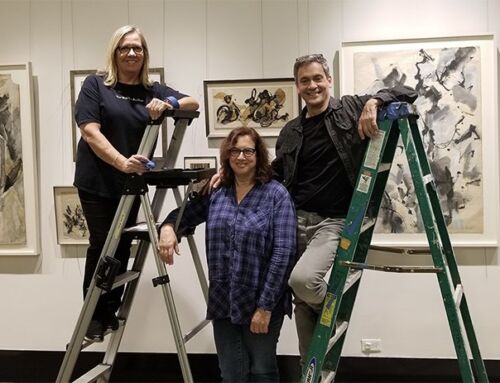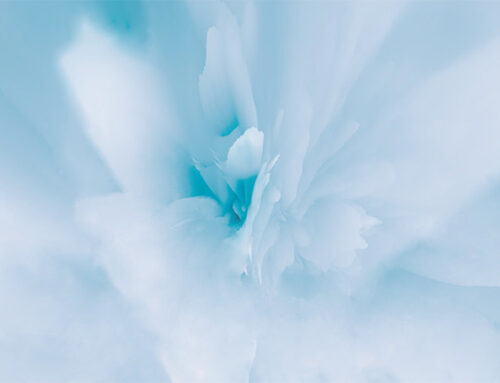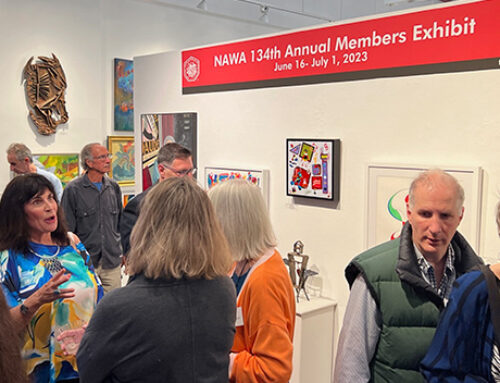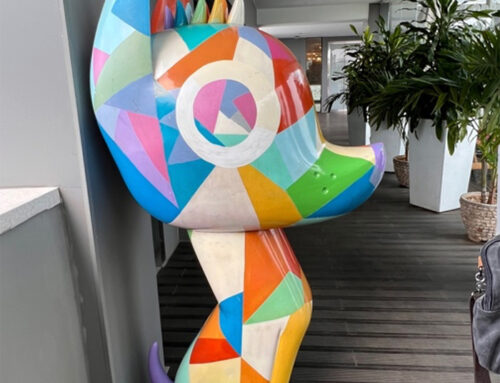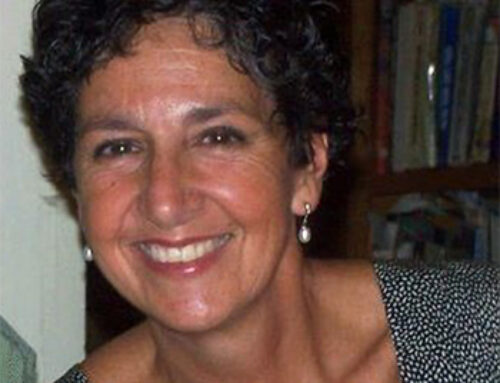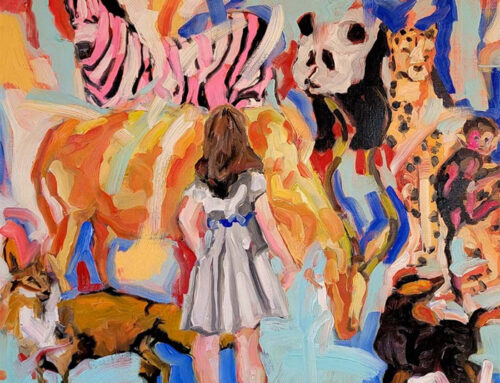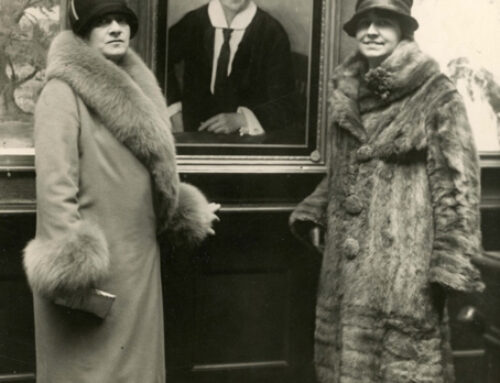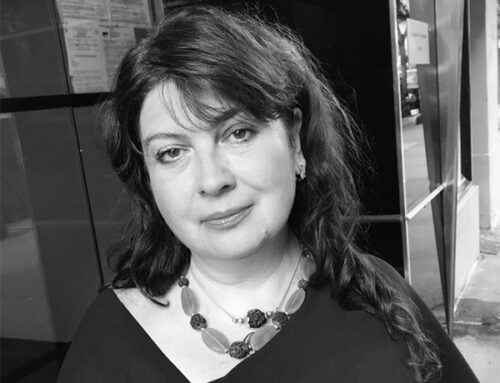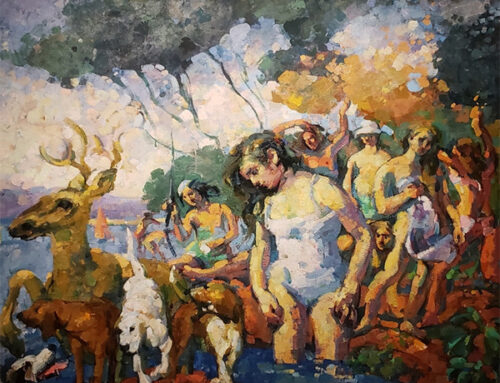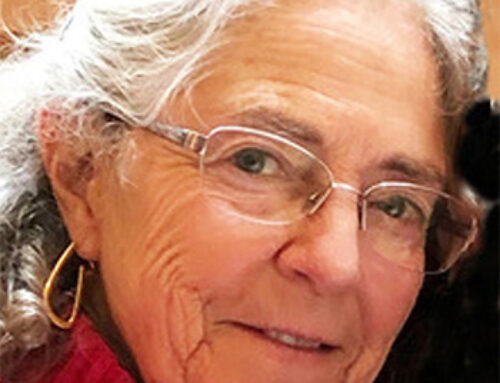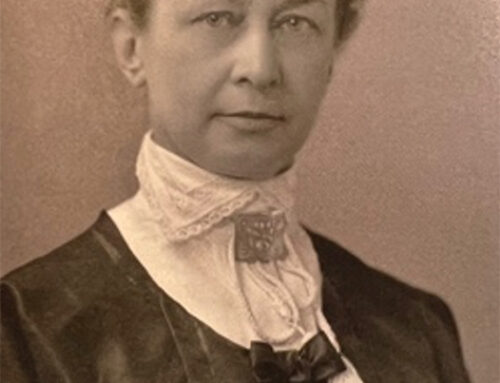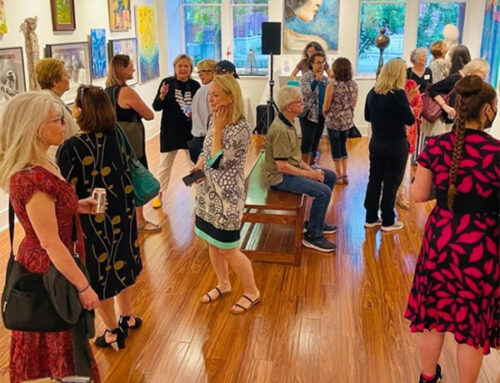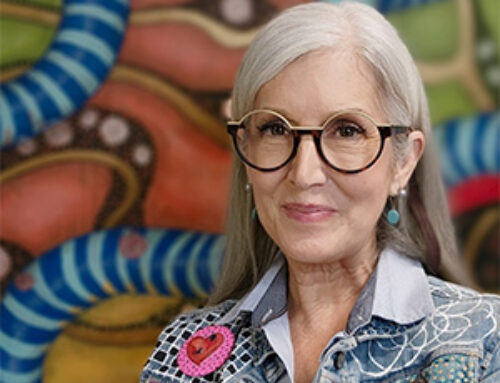Georgia O’Keeffe: To See Takes Time
Seeing Oneself as an Artist
By Sandra Bertrand

Georgia O’Keeffe. It Was Yellow and Pink III, 1960. Oil on canvas, 40 × 30″ (101.6 × 76.2 cm). The Art Institute of Chicago. Alfred Stieglitz Collection, bequest of Georgia O’Keeffe. © 2023 Georgia O’Keeffe Museum / Artists Rights Society (ARS), New York.
GEORGIA O’KEEFFE: To See Takes Time at MOMA is a rare opportunity to see how this American legend saw herself. This is not the O’Keeffe that the world shaped as the well-weathered genius who gave us, signed, sealed, and delivered, the cow skulls and erotically charged flowers all too familiar to her audiences. This is a woman who from her first drawings, understood abstract forms and let them become her “songs.”
Music played an ever-present role in her creations. “Words and I are not good friends at all,” she admitted, so she slaved away at the violin instead, trying to find its voice. Early teachers encouraged her to listen to music while composing her drawings and she was receptive to that advice. Primarily works in graphite, charcoal, pastel, and watercolor dazzle the eye and demand a closer look. Alfred Stieglitz, an early mentor and later husband, celebrated her “burning watercolors” and named her the “spirit of 291,” the gallery he created to promote modernism.
Even if an undeniable simplicity was often at play in her compositions, she was not about to be defined as the “Great Child” he envisioned her as. Moving permanently to New Mexico in 1949 after twenty years of summering in her chosen home, she still felt the stirrings of wanderlust. Peru beckoned in 1956 and a trip around the world in 1959. Hers was an art of shifting perspectives and this exhibit of over 120 works proves that in the air or on the ground, she was her own woman.
Herstory
“Herstory” is the first comprehensive New York museum survey of work
by Judy Chicago (b. 1939, Chicago, IL).
October 12, 2023 to January 14, 2024.

Judy Chicago, Birth Trinity, from the Birth Project, 1983. Needlepoint on canvas. Needlework by Susan Bloomenstein, Elizabeth Colten, Karen Fogel, Helene Hirmes, Bernice Levitt, Linda Rothenberg, and Miriam Vogelman. Courtesy The Gusford Collection. ©️ Judy Chicago/Artists Rights Society (ARS), New York. Photo: Donald Woodman/ARS, New York
Second Floor, Third Floor, and Fourth Floor
“Judy Chicago: Herstory” will span Judy Chicago’s sixty-year career to encompass the full breadth of the artist’s contributions across painting, sculpture, installation, drawing, textiles, photography, stained glass, needlework, and printmaking. Expanding the boundaries of a traditional museum survey, the exhibition will place six decades of Chicago’s work in dialogue with work by other women across centuries in a unique Fourth Floor installation. Entitled “The City of Ladies,” this exhibition-within-the-exhibition will feature artworks and archival materials from over eighty artists, writers, and thinkers, including Simone de Beauvoir, Hildegard of Bingen, Artemisia Gentileschi, Zora Neale Hurston, Frida Kahlo, Hilma af Klint, and Virginia Woolf, among many others.
Taking over three floors of the Museum, “Herstory” will trace the entirety of Chicago’s practice from her 1960s experiments in Minimalism and her revolutionary feminist art of the 1970s to her narrative series of the 1980s and 1990s in which she expanded her focus to confront environmental disaster, birth and creation, masculinity, and mortality. Contextualizing her feminist methodology within the many art movements in which she has participated—and from whose histories she has frequently been erased—“Herstory” will showcase Chicago’s tremendous impact on American art and highlight her critical role as a cultural historian claiming space for women artists previously omitted from the canon.
“Judy Chicago: Herstory” is curated by Massimiliano Gioni, Edlis Neeson Artistic Director, Gary Carrion-Murayari, Kraus Family Senior Curator, and Margot Norton, Chief Curator, Berkeley Art Museum and Pacific Film Archive (former Allen and Lola Goldring Senior Curator at the New Museum), with Madeline Weisburg, Curatorial Assistant.
The exhibition will be accompanied by a fully illustrated catalog co-published by Phaidon and the New Museum, featuring a conversation between the artist and Massimiliano Gioni, and contributions by Glenn Adamson, Connie Butler, Gary Carrion-Murayari, Ann Goldstein, Jennifer Higgie, Candice Hopkins, Amelia Jones, Quinn Latimer, Margot Norton, Kymberly Pinder, Madeline Weisburg, and Carmen Winant.
Cooper Hewitt to Present “An Atlas of Es Devlin” in Fall 2023
Celebrated Artist and Designer Es Devlin To Install 30-Year Archive in First Monographic Museum Exhibition
Cooper Hewitt, Smithsonian Design Museum will present “An Atlas of Es Devlin” from Nov. 18 through Aug. 11, 2024. The genre-defying British contemporary artist and designer Es Devlin (b. 1971) is globally renowned for her large-scale, illuminated installations and sculptures for performances. Her wide-ranging practice, which began in small-scale theater, has been experienced by millions in some of the world’s most prominent museums, galleries, opera houses, arena and stadia. Her highly collaborative work is at once deeply personal and inherently collective. Devlin views the audience as a temporary society and invites public participation in communal works to encourage profound cognitive shifts.
For her first monographic museum exhibition, Devlin will install her 30-year archive across the third floor of the museum. “An Atlas of Es Devlin” will feature over 300 sketches, paintings, illuminated paper cuts and projection-mapped rotating miniature sculptures that form the seeds of some of the most iconic, cultural congregations of music, poetry, art and activism in recent times.
The exhibition will include previously unseen small-scale works that led to major public sculptures and choral installations exploring biodiversity, linguistic diversity and artificial intelligence (AI)-generated poetry at Tate Modern, V&A, Serpentine, Imperial War Museum, Superblue Miami and Lincoln Center, as well as kinetic stage designs at the Metropolitan Opera, La Scala and London’s Royal Opera House, Royal Ballet and National Theatre. It will feature the sketches, paintings and mechanical cardboard models that evolved into the London 2012 Olympic Closing Ceremony, the 2022 NFL Super Bowl half-time show with Dr. Dre and Kendrick Lamar, as well as monumental, illuminated stage sculptures for Beyoncé, U2, Rosalía and The Weeknd.
“An Atlas of Es Devlin” will examine the origins, rigor and depth of Devlin’s process through a compelling journey into her 30-year archive, charting the evolution of form, scale and intention in her practice, from teenage drawings and paintings, to designs for theater, opera, stadium concerts and ceremonies, to her current engagement with climate and civilizational crises. The exhibition will reveal thematic connections and trace the development of her groundbreaking ephemeral architectures.
“Es Devlin’s polymathic practice dissolves boundaries between art, activism, design, poetry, sculpture, music and architecture,” said Andrea Lipps, associate curator of contemporary design and head of Digital Collecting at Cooper Hewitt. “Within an environment conceived by Devlin herself, this exhibition will immerse visitors in the artist’s studio and archive. Centering archival artifacts, the exhibition will reveal the remarkable breadth, rigor and iterative process underlying Devlin’s transformative, multidisciplinary work.”
“I have spent 30 years translating words into images and spaces—transforming texts on a page into kinetic sculptures that encompass viewers with light and song and use magic to alter their perspective,” Devlin said. “My craft is to imagine worlds that don’t yet exist, to invite audiences to practice ‘interbeing’ within psychological architectures they have not previously inhabited, to remind viewers that they are not separate but connected to one another and to the biosphere. For this exhibition, I have gathered the drawings, fragile paper sculptures and small-scale revolving cardboard models that I and my studio team have been making over the past three decades, a miniature parallel practice at the root of the large-scale public performance and installation works.”
About Es Devlin
Devlin creates large-scale sculptural installations that combine light, music and language. Her work is rooted in a lifelong practice of reading and drawing, from the plays, song lyrics and opera libretti that have informed her performance sculptures, to the works of fiction, poetry, geo-philosophy, anthropological economics, biology and climate science that have formed the foundation of her art and activism over the past decade. She views an audience as a temporary society and encourages profound cognitive shifts by inviting public participation in communal choral works. Her temporary participatory sculptures have been displayed at Tate Modern, Serpentine, V&A, Barbican, Imperial War Museum and Trafalgar Square.
“Come Home Again,” her 16-meter-high monumental choral sculpture outside Tate Modern, drew over 7,000 visitors each day to join diverse London choirs and species in choral song during its showing in September 2022. Her rotating illuminated sculpture, “Your Voices,” entangled viewers within the 700 languages spoken in New York City in collaboration with the Endangered Language Alliance in December 2022.
Her expansive mirrored “Forest of Us” invites viewers to inhabit the visual symmetry between the bronchial structures that allow people to breathe and the branching tree geometries that make breathing possible. The installation is still on view, having inaugurated Superblue Miami alongside new works by James Turrell in 2020.
Devlin’s collective AI-generated poem continues to evolve online having been initiated in 2016 as “Poemportraits” at the Serpentine. It formed the basis of the UK Pavilion at the World Expo 2020, the first building to generate a collective poem on its facade every minute.
She has created monumental luminous stage sculptures for Beyoncé, The Weeknd and U2, The Royal Opera House, National Theatre, La Scala and The Met Opera as well as the 2022 NFL Super Bowl half-time show featuring Dr. Dre, Kendrick Lamar and Eminem and the 2012 London Olympic Closing Ceremony.
She was the subject of the Netflix documentary “Abstract: The Art of Design,” and has received multiple Olivier, Tony and Emmy awards, as well as an Ivor Novello award and a CBE.
For more information, visit www.cooperhewitt.org or follow @cooperhewitt on Instagram, Facebook, Twitter and YouTube.
Berthe Morisot: Still Emerging from the Margins?

Morisot, 1880. Photo credit: Les plus belles oeuvres de Berthe Morisot, © Larousse (2019)
By Patrice Boyes, Co-Editor
PARIS (July 12, 2023) – Impressionist painter Berthe Morisot, a frequent portrait model for her brother-in-law Édouard Manet, occupies a small but notable sidebar in the current 150-piece Manet/Degas comparative exhibition at the Musée d’Orsay. Quelle surprise!
In addition to the familiar Manet portraiture featuring her with a bouquet of violets, a fan, or seated at a bright green balcony rail, the curators included a special panel, “The Morisot Circle,” to describe Morisot’s own artistic roots and the “hotbed of modernity” comprising her family’s influential circle in Paris. In the late 19th Century, Morisot’s parents hosted a popular Tuesday salon at which Morisot and her sister mingled with musicians, writers and artists, including Corot, Manet and Degas. The café scene was forbidden to girls of their social standing along with its networking opportunities. Consequently, the sisters studied art and painted in a family studio at home.

Berthe Morisot with a Bouquet of Violets, Manet (1872), oil on canvas; Paris, Musée d’Orsay
In a tale familiar to NAWA members, Morisot (1841-1895) exhibited at the Paris Salon and figured prominently in the breakaway annual Impressionist exhibitions in Paris but was ignored by the male-dominated establishment. More than 125 years after her death, Morisot’s importance is still emerging. New scholarship has been published about her work. But Morisot still is not widely displayed in public collections.
“What a shame they are not men,” Manet wrote of Berthe and Edma Morisot upon meeting the talented sisters in 1868, as the Guardian reported April 2, 2023, on the occasion of the first major exhibition of Morisot’s work in the United Kingdom since 1950. (“Berthe Morisot: Shaping Impressionism” runs until September 10, 2023 at the Dulwich Picture Gallery in south London.)

Mary Cassatt at the Louvre, Degas (1885), pastel; Chicago, The Art Institute of Chicago
Venerable art critic Peter Schjeldahl of The New Yorker excoriated organizers of a Morisot retrospective in 2018 for the “strategic irritant” of the exhibit’s subtitle, “Berthe Morisot: Woman Impressionist.” Schjeldahl added, (“Imagine a parallel case: say, “Georges Braque: Man Cubist.”) Schjeldahl believed Morisot was due for full-blown fame owing to her “feats of form and depths of meaning that were still developing” when she died from pneumonia, in 1895, at the age of 54. His full article dated October 22, 2018 may be found at here. The 2018 exhibit was the first to show Morisot’s work in the U.S. since 1987, the first ever solo exhibit of her work in Canada, and the first French solo exhibit of her work since 1941.
Manet/Degas examines the similarities and differences of the two painters, who were acquainted but sometimes at odds with one another. The exhibit was organized by The Metropolitan Museum of Art, New York, and the Musées d’Orsay et de l’Orangerie, Paris. It will open at The Met on September 23, 2023, and close January 7, 2024. In addition to a nod to Morisot, NAWA members will delight to find Degas’ pastel “Mary Cassatt at the Louvre” (1885) among the works on exhibit.



